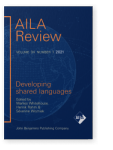An invisible operational mortar
The essential role of speech acts within tri-segregated moviegoing
The contribution seeks to apply the principles of J. L. Austin’s speech-act theories to the study of local business segregation in the Jim Crow South. In particular, it borrows the notions of illocutionary and perlocutionary force when examining the seemingly bland and prosaic statements that are often used to normalise segregation within the business of commercial entertainment. For purposes of expanding the complexity of typical Manichaean (i.e., Black vs White) ethnic studies, this analysis was developed within the context of tri-racial segregation as applied to rural moviegoing within Robeson County, North Carolina during the first half of the twentieth century. Notably, the development of Robeson’s historical cinema-exhibition spaces eventually resulted in a highly unusual venue – i.e., the three-entrance theatre – whose physical architecture reflected tensions between local ethnic demographics and desired social hierarchies. Yet even in the face of these unusual physical constructs, this study contends that seemingly everyday objective/descriptive and non-demonising language remained an essential component in enforcing segregation.
Article outline
- 1.Introduction
- 2.Robesonian segregation in the Jim Crow era
- 3.Review of Austinian speech-act theory
- 4.Applying speech-act theory to early moviegoing artefacts in Robeson County
- 5.Initial tri-racial accommodations
- 6.Three-entrance theatres
- 7.The mortar between the bricks
- 8.Local resistance
- Note
-
References
References (19)
References
Austin, J. L. (1961a). The meaning of a word. In J. O. Urmson & G. J. Warnock (Eds.), Philosophical papers by the late J. L. Austin (pp. 23–43). Oxford University Press.
Austin, J. L. (1961b). Truth. In J. O. Urmson & G. J. Warnock (Eds.), Philosophical papers by the late J. L. Austin (pp. 85–101). Oxford University Press.
Austin, J. L. (1961c). Performative utterances. In J. O. Urmson & G. J. Warnock (Eds.), Philosophical papers by the late J. L. Austin (pp. 220–239). Oxford University Press.
Austin, J. L. (1962). How to do things with words (J. O. Urmson, Ed.). Harvard University Press.
Barnes, M. (2016). Speaking with (subordinating) authority. Social Theory and Practice, 42(2), 240–257. Retrieved on 24 May 2021 from [URL]. 
Bindas, K. J. (2010). Re-remembering a segregated past: Race in American memory. History & Memory, 22(1), 113–134. 

Hill, J. H. (1998). Language, race, and white public space. American Anthropologist, 100(3), 680–689. 

Keating, E., & Duranti, A. (2011). Discourse and culture. In T. A. van Dijk (Ed.), Discourse studies: A multidisciplinary introduction (pp. 331–356). Sage. 

Leezenberg, M. (2013). Power in speech actions. In M. Sbisà & K. Turner (Eds.), Pragmatics of speech actions (pp. 287–312). De Gruyter. 

Lowery, M. M. (2007). Lumbee Indians in the Jim Crow South: Race, identity, and the making of a nation. UNC Press Books.
Lowery, M. M. (2018). The Lumbee Indians: An American struggle. UNC Press Books. 

McKenna, C. J. (2007). Tri-racial theaters in Robeson County, North Carolina, 1896–1940. In R. G. Maltby, M. Stokes, & R. C. Allen, Going to the movies: Hollywood and the social experience of cinema (pp. 45–59). University of Exeter Press.
McKenna, C. J. (2013). Chasing Mr. C: Early motion-picture exhibition in Robeson County, North Carolina (1896–1950) (Order No. 3562776). Available from ProQuest Dissertations & Theses Global.
Musser, C. (2004). Historiographic method and the study of early cinema. Cinema Journal, 44(1), 101–107. 

Sbisà, M., & Turner, K. (2013). Introduction. In M. Sbisà & K. Turner (Eds.), Pragmatics of speech actions (pp. 1–21). De Gruyter. 

Searle, J. (1976). A classification of illocutionary acts. Language in Society, 5(1), 1–23. 

The Robesonian. (1870). W. Wallace McDiarmid.
Woldemariam, H., Lanza, E., & Blackwood, R. J. (2016). Negotiating and contesting identities in linguistic landscapes. Bloomsbury Academic.
Woodward, C. V., & McFeely, W. S. (2002). The strange career of Jim Crow. Oxford University Press.
Cited by (1)
Cited by one other publication
Rădulescu, Maria Alina, Wim Leendertse & Jos Arts
2023.
How Can Co-Creation Support Capacity Building for Adaptive Spatial Planning? Exploring Evidence from a Co-Creative Planning Process in The Netherlands.
Planning Theory & Practice 24:5
► pp. 639 ff.

This list is based on CrossRef data as of 4 july 2024. Please note that it may not be complete. Sources presented here have been supplied by the respective publishers.
Any errors therein should be reported to them.
